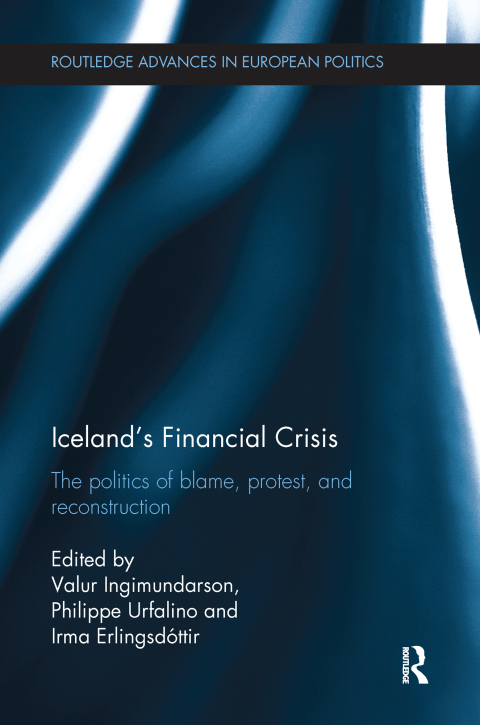Description
Efnisyfirlit
- Cover Page
- Half Title page
- Series page
- Title Page
- Copyright Page
- Contents
- Figures
- Tables
- Notes on contributors
- Preface
- Abbreviations
- Introduction
- Coming to terms with crisis
- The macro- and micro-economic background
- The politics of protest, debt, and justice
- Constitutional reform as a societal transitional mechanism
- Notes
- Bibliography
- Part I The road to economic disaster
- 1 Iceland’s financial crisis An economic perspective
- Macro-economic developments preceding the crisis
- Financial escapades become visible
- Social pressures drown voices of protest
- The downturn and its causes
- Conclusion
- Notes
- Bibliography
- 2 The rise and fall of a financial empire Looking at the banking collapse from the inside out
- The privatization process
- The unsustainable expansion of the banking system
- The banks’ skyrocketing growth of assets
- Questionable banking practices: cross-ownership and market manipulation
- The point of no return
- Conclusion
- Notes
- Bibliography
- 3 The political economy of Iceland’s boom and bust
- Introduction
- Accounting for financial crises
- Regulation and empirical experience
- Accounting for the Icelandic boom and bust
- Policy precondition: the shift toward neoliberalism
- Changed institutional environment
- From banking privatization to a bubbling economy
- Debt accumulation—how much and who did it?
- Why did they do it?
- Speculation: “Wall Street on the Tundra”
- Increased inequality: big gains at the top
- Conclusions
- Notes
- Bibliography
- Part II The political and societal responses to the crisis
- 4 Political opportunity, framing, and mobilization in Iceland’s post-crash protests
- Grounded work
- The emergence of political opportunity
- Credibility crisis
- Disruption of the taken-for-granted
- Perception of opportunity
- Framing the crisis
- Emergence of a collective action frame
- Exploring voices on the ground
- Conclusion
- Notes
- Bibliography
- 5 Contentious politics, political expediency, and the real costs of the Icesave debt
- The context: a brief history of the Icesave dispute
- Political process theory and theories of participatory governance
- The Icesave dispute: the role of governance and democratic engagement
- Icesave and the Icesave referenda as democratic achievement
- Icesave and the Icesave referenda as political expediency
- Conclusion
- Notes
- Bibliography
- 6 Democratic practices, governance, and the financial crash
- Investigations of the financial collapse
- Policies of regulation
- Political practices
- The media and the public sphere
- Weaknesses in Icelandic democratic culture
- Post-crash democratic experiments
- Conclusion
- Notes
- Bibliography
- 7 The politics of transition, memory, and justice Assigning blame for the crisis
- Introduction
- Defining the nature of a societal shock
- Juggling restorative and retributive justice
- Conclusion
- Notes
- Bibliography
- 8 The strategy of redistribution Iceland’s way out of the crisis
- Introduction
- The policy debate: stimulus, austerity, or a mixed approach?
- The strategy of redistribution
- Iceland’s progress through the crisis
- Policy profiles: how to cut and not cut welfare expenditures
- Activation stepped up
- Poverty contained
- Debt relief
- Conclusions
- Notes
- References
- Part III The politics of Iceland’s constitutional reform
- 9 Icelandic constitution-making in comparative perspective1
- Upstream moments
- Midstream moments
- Downstream moments
- Upstream moments in Iceland
- Midstream moments in Iceland
- Downstream moments
- Notes
- Bibliography
- 10 Constitution on ice
- Historical background
- The making of Iceland’s post-crash constitution
- Constitutional assembly elected
- Enter the Supreme Court
- National referendum
- Parliament’s turn
- What went wrong?
- Does the bill go too far?
- What happened next
- Some criticisms
- Conclusion
- Notes
- Bibliography
- 11 Constitutional revision A weak legislative framework compounded by political disputes
- A unique task in unprecedented times: civil society and the crash
- Rationalizing constitutional change in Iceland
- Disputes over fundamental constitutional questions
- Civil society and the constitutional process
- Conclusion
- Notes
- Bibliography
- 12 Constituent power and authorization Anatomy and failure of a constitution-making process
- Theoretical approaches to constitution-making
- Authorship and authorization: the case of Iceland
- Conclusion
- Notes
- Bibliography
- 13 The Constitutional Council Objectives and shortcomings of an innovative process
- Motives for constitutional revision
- Constitutional reforms: aims—and setbacks
- The proposals of the Constitutional Council
- Exercising the constituent power by drafting a constitution:an assessment
- Conclusion
- Notes
- Bibliography
- 14 The Constituent Assembly A study in failure
- Public against Parliament: the activist face of the Constitutional Council
- From clean slate to consensus: methodological weaknesses
- We—the people: the public again
- Transitional solidarity
- Conclusion
- Notes
- Bibliography
- Index







Reviews
There are no reviews yet.